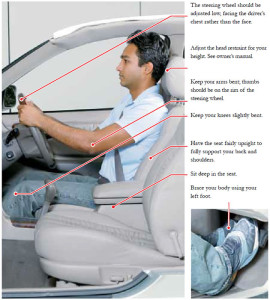Checking Blind Spots On Your Driving Test
Based On The NSW Guide To The Driving Test. guide-to-driving-test
Blind spots checks are also known as head checks and shoulder checks.
If you miss three blind spot checks on your driving test you will probably fail. So every time your blinker is blinking check the appropriate blind spot. Every time.
You must turn your head and check your blind spots before:
• Changing lanes.
• Leaving or returning to the kerb.
Before leaving the kerb, blink for at least 5 seconds and the very last thing before you move your car is a blind spot check.
Returning to the kerb, check your left blind spots.
• Merging or diverging.
• Reversing.
Before reversing, check three mirrors and both blind spots, looking mainly over your left shoulder out the back window while reversing.
• Turning left – looking for pedestrians, bicycles and motorcycles that could be
beside you in your blind spot.
Every time you turn left, blink and check your left blind spot – well before the turn. NOT during the left turn.
• Turning right – looking for vehicles that may be overtaking you.
Before making any right turn, check your right blind spot, looking for cars, bikes etc overtaking you on the right.
You can do the check as you approach the right turn or just before the turn.
• Joining the traffic stream.
• Leaving the inside lane of a multi lane roundabout.
When you are on the inside or right lane check your LEFT blind spot as you leave the roundabout. You are making sure the traffic in the left lane is not going to turn in front of you.
On your driving test slow down for roundabouts and then you will time to blink left when leaving plus check your blind spot.
When reversing you must turn your head and look over your shoulder to check
through the rear window for vehicles and pedestrians that may not be visible
in your mirror. All vehicles have blind spots behind.
Any questions please call or contact me. If you want to book a driving lesson please call. 0438 364 244


